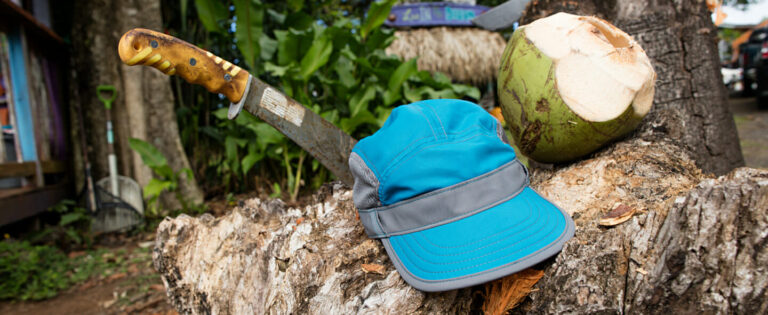There are so many dangers you can encounter in alpine terrain. For example, the other day there was this chap who got his beard caught in a figure eight descender. Can you believe that? Oh, have you ever heard the story about that person who got nailed in the thigh with an ice axe? Where was that again? I think it was in Chamonix. There was even someone else there who got strangled by the sling he had around his shoulders. And, what about the woman who drowned in a half-thawed snowfield? Awful. When you start thinking about all the potential risks and hazards you could encounter in the mountains, you might be tempted to cancel the next adventure you had planned with your mates at the last minute. But that isn’t necessary – after all, there IS such a thing as being too careful!
Even though it’s important to be aware of the hazards of the high mountains described in this article, try not to focus on them too much. As a healthy compromise, we recommend you learn what you need to know in order to recognise as many realistic dangers as possible (without making yourself crazy). Recognise and acknowledge the positive aspects of the mountains at least as much as you do the dangers, but don’t let anything lessen your excitement about your upcoming trip.
Of course, it isn’t always easy to draw the line between healthy optimism and recklessness. Most accidents in the mountains happen when someone incorrectly assesses this line. That’s why, especially if you’re a beginner, it’s important to reduce the difficulty and demands of the climb you’re planning if you aren’t absolutely sure of yourself. And remember: it’s always better to turn around if any uncertainties or delays pop up (such as weather developments or the pace of other members of your group).
Sources of danger

In the mountains, almost anything can become a potential source of danger: the slippery, loose terrain, the wrong shoes, a storm cloud lurking behind a mountain, or the trail that leads to a wall of boulders. Even cows were recently identified as an alpine danger – a series of unusual attacks really caused people to rethink the supposed harmlessness of the wide-eyed ruminants. But, overall, the risk of being gored by mad alpine cows is fairly low. Let’s look instead at the “classic,” more regular mountain dangers.
The mountain and its environment
There was a time when being anywhere near a mountain was considered dangerous. Not only did you have to worry about avalanches and ice, you also had dragons and evil spirits to contend with. The super-natural threats may have gone by the wayside, but the mountains still have plenty of other hazards to throw at you.
Terrain
High rock walls, narrow ridges and paths that snake along ledges. Falling from icy rocks has been the most emblematic danger of all ever since the drama of the first ascent of the Matterhorn. And it’s true – climbing that high gives you plenty of opportunities to fall all the way back down. But, it doesn’t even need to be an incredibly steep ascent. If you’re travelling on hard glacial ice, even a slight incline is enough to end in an unstoppable slide if something goes wrong.
Avoiding danger: Plan your trip in accordance with your skill level and stay focused when you’re travelling through terrain that could increase your risk of falling. If you need to rope up, you should know the techniques and your equipment like the back of your hand. If not, you should turn around.
Rocks
Weathering, erosion and permafrost determine how stable the rocks and mountains are. Wherever the rock formations are crumbling, loose rocks, blocks or even entire rock formations can come loose. The former is referred to as rockfall; the latter as a rock slide. A major rock slide is called a landslide. In this situation, of course, a helmet won’t be much help. But the risk of getting hit by such large amounts of rock is fairly low.
In most alpine regions, there is a geological monitoring system that predicts rock slide and landslides so that the areas can be closed off in time. But there is still no guarantee when it comes to these forces of nature.

Avoiding danger: An appropriate helmet can help to prevent injuries cause by loose rock or blows to the head while climbing. It’s always important to remain alert and ready to react quickly when travelling through terrain with a high risk of falling rocks. When rocks come tumbling down, move as quickly as you can while staying as close as possible to the slope or rock face (under a ledge, if possible, with your face turned towards the rock face) and protect your head with your backpack or, if that isn’t possible, with your arms.
When climbing, there is also always the risk that a hand or foothold, or an anchor could give out. The best way to prevent this happening is to test the rock’s stability by tapping it. A deep, quiet tone indicates that it is stable. A loud, echoing, hollow sound, on the other hand, means caution.
Ice
Ice is also known to come falling from above. This isn’t something hikers usually encounter, but mountaineers certainly do. Mountaineers often have to deal with icefall or even hanging glaciers. The level of risk depends mostly on the temperature and the stability of the ice formation. The basic rule is: the faster the ice froze, the lower the risk that something will break off.
Safety measures are more or less the same as with falling rocks. However, timing and planning are even more important here. You should get past areas in which there is a risk of falling ice as early in the day as possible.

Snow
Snow masses pose a danger primarily to ski tourers, snowshoe goers, freeriders, and other winter mountain athletes. It’s important to carefully check the avalanche warnings and become well acquainted with the subject in both theoretical and practical terms. A good place to start is, for example, the Base Camp Blog article about planning a ski tour.
Solitude –infrastructure – supplies
Despite dense development in the Alps, hikers and mountaineers will still occasionally find themselves in places where it’s not as easy to get your next latte macchiato fix. To ensure that you always have enough energy to meet any challenges that come your way, you’ll need sufficient fuel in the form of food and water , since the latter can be very scarce above the snowline.
Avoiding danger: The great majority of emergency situations can be avoided from the get-go with forward-looking, cautious, and – when possible – flexible planning.
The sun at high altitudes
The more intense UV exposure isn’t the only sun-related risk in the mountains – the heat can be a problem, too. At high altitudes, the harmful UV rays are reflected and absorbed to a lower degree because the atmosphere is thinner. Instead, they come straight through to our skin. Heat can start taking a toll on you much more quickly at alpine altitudes than down in the valley because of the dry air and the often high level of exertion. The strong sunlight, which is reflected intensely by the snow, can really strain the eyes and lead to headaches or even snow blindness.
Avoiding danger: Most people should be familiar with the relatively simple and efficient protective measures needed here: wear a well-fitting sun hat, use good sunblock and have a good pair of sunglasses or glacier glasses. Top that off with small sips of water at regular intervals to prevent you feeling to thirsty and you shouldn’t have any problems with the sun in the mountains.
Air pressure – oxygen level
When people reach high altitudes, various temporary changes to the body become noticeable. Depending on the speed and altitude of the ascent, these changes can be more or less intense and unpleasant. At an altitude of 2000m or so, most people notice a difference in the way they feel compared to sea level. They might get tired more quickly, get headaches or feel dizzy.

If you ascend too quickly, life-threatening altitude sickness can occur. This is caused by rapid exposure to lower amounts of oxygen. Whilst the oxygen percentage is actually the same at any altitude, at higher altitudes the air is “thinner” and there are fewer air molecules available, which means there are fewer oxygen molecules.
It’s very easy to avoid this danger as well: give the body enough time. It has no problem adapting to the reduced oxygen – it just needs to produce more red blood cells. This process can take anywhere from an hour to days, depending on the altitude and speed of ascent (or even weeks, if we’re talking about the biggest mountains in the world). During the adjustment period, the body is operating at reduced capacity and has an increased need for fluids, so it’s important to take in enough water and minerals.
In the Alps, you can head to the highest summits after spending a few days at 2000m altitude and getting acclimated with one or two tours on smaller mountains at an altitude of 2500 – 3500m. There’s also the “trick” of ascending and descending so quickly that the body “doesn’t notice” the change in altitude. While this strategy might indeed work on some four-thousand metre mountains, it puts a lot of stress on the body and is not entirely safe, either. You wouldn’t want to get stuck up there somewhere.
Weather

The higher you are, the more heavily you are exposed to the wind and weather. This is mostly due to the fact that, at increasing elevations, there are less obstacles and frictional resistance to wind flow from the ground and terrain. Other weather elements, such as precipitation and temperature, are more intense because the mountains build a barrier where clouds accumulate, pile up and release rain. This is why weather changes and storms usually occur more suddenly and violently in the mountains than in the lowlands.
Avoiding danger: How to best protect yourself is no great secret here, either. First, make sure to get the most accurate weather forecast possible and base your (more cautious/defensive) planning on that. During the trip, observe the weather as continuously as possible and compare it to the forecast. Of course, you should always bring an insulated jacket or an insulated jumper as well as a waterproof jacket with you in the mountains, even in the most beautiful summer weather.
The most complicated risk: people
Warning – things are about to get philosophical. Believe it or not, the complexities of human beings travel with them into the mountains, along with their various behaviour choices and opportunities to make mistakes. People also tend to be irrational and make decisions on the basis of extreme internal and external states: from exhausted to wide awake, from annoyed to euphoric, from resigned to inspired, from panicked to reckless. All these states can increase or decrease the dangers ¬– it all depends. One can lead to a shortening or cancellation of the trip just in time or result in very risky decisions.
Being in excellent physical condition, for example, can lower the risk when someone is travelling more quickly. But it can also increase the risk if it leads someone to take on more than they can handle.
Physical conditioning
When turning around is not an option, or you find yourself high up on a challenging mountain, (premature) fatigue becomes the greatest risk factor. Subjective feelings of tiredness can be deceptive, which is why you should pay attention to external signs. Slower reaction times and waning concentration and coordination are reliable markers of physical fatigue.

The lower your physical fitness is, the more quickly you will become fatigued. It sounds trivial, but in practice it can be tricky to manage. You need to know your own body quite well to be able to compare your own abilities with the numbers and data of the route you’re planning. If the comparison is successful, you’ll have a realistic self-assessment and will feel neither over- nor underwhelmed on the trip.
Most people need experience (including a few failed trips) to arrive at a realistic self-assessment. Ideally, the increasing experience comes with increased fitness from training and improved technical skills (better ascent and climbing technique, more efficient handling of gear, etc.).
Physical capacity is influenced by a great number of physical and psychological, internal and external factors such as orienteering skills, equipment or tactics. The more you know about these factors and the more you consciously incorporate and train them, the lower the risk the planned route will have.
It gets even more complicated when multiple people are travelling together. Then the psychological factors gain in importance and the group dynamic produces its colourful results.
Equipment

The more challenging the route, the more sources of danger there will be and the more your equipment will become a potential risk factor. There are an infinite number of ways that ice axes, crampons, ropes, carabiners, etc. can be used incorrectly and land you in hot water. The book series “Sicherheit und Risiko in Fels und Eis” by Pit Schubert [translation: “Safety and Risk on Rocks and Ice”, available only in German] explains the absurd mishaps and accidents that can happen in these situations.
Are there subjective and objective risks?
The traditional way of describing mountain hazards divides them up into subjective and objective hazards. Subjective dangers are said to be those that come from within, meaning that they develop within the person themselves. Objective hazards are said to be those that come from outside, that is, from the mountain. This differentiation suggests that only some of the hazards can be entirely avoided, whilst the remaining objective hazards are uncontrollable and should be considered a residual risk.
But now, many take up the position that there are no objective hazards because risks only arise as a result of subjective decisions. Even the risk of falling rocks and avalanches comes from the subjective decision to travel in the mountains in the first place. By making this decision, people willingly put themselves in a bit of danger – much like when we willingly accept a certain amount of danger by getting in a car.
Conclusion
Yes, there are many hazards ‘lurking’ in the mountains. That’s the bad news. But the good news is: the great majority of these risks can be easily eliminated or minimised. As long as the trip is planned appropriately for the members of the group and the expected weather, more than half the battle is already won! And, the more (sensible) trips you go on, the more experience you will gain – and experience is one of the most valuable resources of all. It makes it possible to develop “mountain sense”, a feel for the mountain “that is like a sixth sense or a radar for recognising alpine dangers. You develop this sense by accumulating experience and how you reflect upon your experiences.“ That being said: take care of yourselves and have a great time in the mountains!




